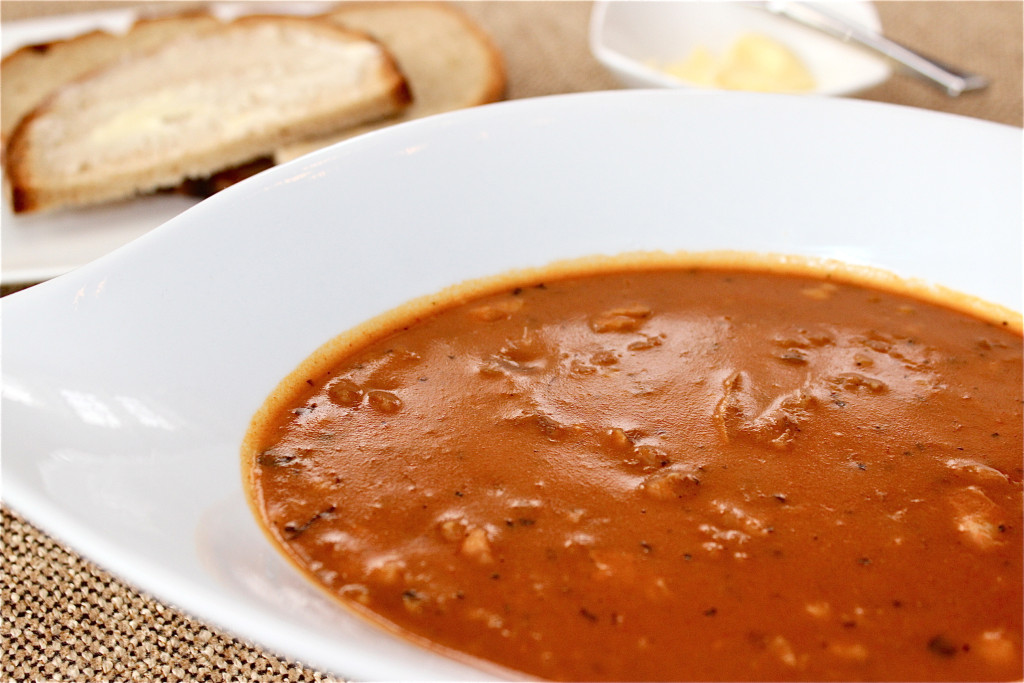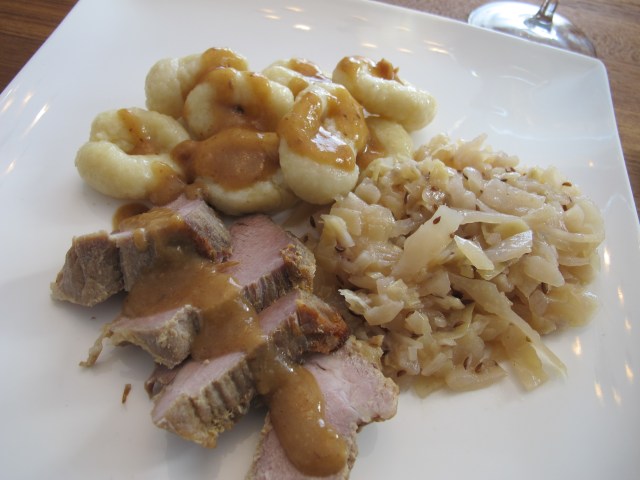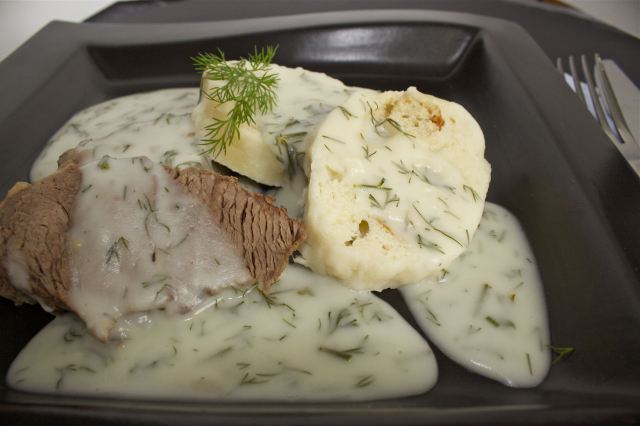Although Nick had studied abroad in the Czech Republic for 6 months, he was almost no help when it came to the food. His favorite food while he was there were these rolls covered in bacon and cheese, which he ate daily. In fact, as near as I can tell his diet in the Czech Republic consisted of those rolls, goulash and beer. He did mention one of the kids he studied with brought a bottle of Ranch dressing with him…Sigh, I don’t know how he survived before I came into his life and taught him about vegetables. Since he was no help, we reached out to Czech food blogger Charlotte of czechinthekitchen.com to learn more about the food and food culture of the Czech Republic.
A bit about her: Charlotte is a Canadian blogger transplanted from the Czech Republic and she believes in tasting food as often as possible whenever cooking or travelling. She follows recipes sometimes but loves food always.
Charlotte’s enthusiasm for the foods she grew up with and her love for Czech foods made her a great resource and she graciously provided plenty of insight into the Czech food culture:
Q: How do you define Czech food? What characteristics differentiate it from similar foods in the region? How has it influenced and been influenced by its neighbors?
A: I would define Czech food as a labour of love since so many of the dishes seem to require a considerable amount of work and time. To me Czech food is a kind of home. I love the various sauces that accompany the meats and the knedles and even though I don’t eat them much these days as I’ve gotten away from some of the heavier dishes I find them comforting. I’ve been hard pressed to find other foods that are as distinctly flavoured as my family’s food. That’s not to say that I don’t enjoy many other foods it’s just they don’t speak to me the way Czech food does. I think that anyone who has an ethnic kitchen in their background experiences the same kind of feeling when it comes to food and it’s probably due to the nostalgia that is associated with food and specific flavours.
Given that the European countries as so close together I think they can’t help but influence each other. I also am a strong believer that there are so many things that are similar from various culture such as the (Ukrainian and Polish) perogies are similar to vereniki (Jewish) and our Czech dumplings (in soups) are similar to matza balls that come from Jewish kitchens. Also the Italians make gnocchi which are similar to a Czech dish as well as similar to the German Kartoffelkloesse. Though the shapes may change and the seasoning may differ slightly so many of the foods from various European places seem to have a relative in another country.

Q: How much influence from Czech foods do you see in Canada?
A: I don’t know that there really is a considerable Czech influence in Canada since there seem to be so few of us in Winnipeg compared to the larger number of other European immigrants. This may be different where there are larger concentrations of Czechs such as in Toronto or Calgary or even State side in places like Chicago but I haven’t really noticed many ‘Czech’ foods in restaurants here.
Q: Food and culture go hand in hand, how does the food reflect the culture in the Czech Republic?
A: I think that the same as ‘meat and potatoes’ were more prevalent in Canada when more people farmed and worked on the land the same is also true of the Czechs. Their dishes were quite heavy with sauces and meats and dumplings or ‘knedle’ but as people work more with paper than in a physical way our diet also shifts.
Q: I love the “carp in the bathtub” tradition at Christmas, can you tell me more about it and its origins?
A: I also always loved this story. Though not really a ‘story’ but how people actually managed to ensure that their fish was fresh for Christmas dinner. People would have had to buy their fish when it was available and if they had to buy it days before Christmas they would buy it live and let it swim in the bathtub. That way it would be fresh because that is what you wanted for a special occasion.
From all the stories I’d been told, as in many other places in the world, the Czech Republic as a country was poor and times were hard. This was before the Communists occupied the country and even once they took over, regardless of how much they promised to make the country a better place, people still struggled. Fresh food was expensive and hard to get often times, Czechs at least were used to getting food everyday for that evening and the next breakfast and lunch. The refrigerators were small as they are today or at least small by North American standards. I shop once a week or so I have a huge fridge and freezer but my relatives still pick up food several times a week. I think this is as much about habit as it is about practicality and also I think it gives people a sense that the food is more fresh than if it sat in their fridge for a week. My mom would say that she stopped for bread at one store then for meat at another and vegetables at another on her way home from work and she would then use the food to make dinner.
I know that when I was there about 8 years ago many of their shopping options have changed. As we have Costco in North America they have a Tesco which is quite similar and certainly not what my mother had access to when she lived there. Some call that progress, some call that gluttony, I for one call that convenience but I suppose that’s what I’m used to.

Q: What are some of your favorite traditional dishes? What are a few “can’t miss” dishes to try?
A: This list on this is so long it’s difficult to narrow it down. I tend to always favour the food I also try to stay away from since they are quite heavy and I just find I can’t eat that way anymore. The bramboracka or potato soup is fabulous as is the tripe soup and these would be very different from other things you may have eaten before. I think that one of the most traditional dishes, pork with cabbage and dumplings is also very good as is the beef with dill cream sauce and dumplings. I would suggest that if you go into Tesco then check out their prepared foods. I recall that their deli has some amazing fish salads. I still eat a fair bit of pickled herring salad which has sour cream and peas and carrots (I have some made in the fridge right now) which is definitely on the healthier side and I have it often. Please forgive the quality of the pictures in these links, I posted these long before I took a photography course and began to figure out how to make the food actually look edible!
I almost neglected to speak about the beer… the beer is amazing! I’ve never been much of a beer drinker but the Czech Republic is certainly known for and proud its beer. You can order all sorts of beer, dark or light beer or ‘rezana’ which essentially means ‘cut’ so it would be half dark and half light and amazingly good. We would often have a rezana as we’re really not connoisseurs but we did enjoy a beer here and there. A nice cold glass goes exceptionally well with a couple of slices of dark bread and tripe soup! This is an awfully abbreviated commentary on Czech beer though… shamefully so actually… so if you’re interested in the beer please visit sites such as this one on Czech Breweries for more information.
Q: How has the food culture changed since the fall of communism?
A: I haven’t really been in the Czech Republic prior to the fall of communism, though I was born there we left when I was a toddler so I don’t have much recollection and I returned once about 8 years ago so I am far from an authority on how things may have changed. I will say that things like the Tesco were nonexistent during communism and though I think they have much more access to things my niece who lives in the Czech Republic would tell you that North Americans are limited since when she was in California for a year she was hard-pressed to find the same kind of variety of cheese when she went shopping. I think we’re all used to the things we have access to and some of those things may not be popular in other countries. Much like I had to send my daughter a jar of peanut butter when she was studying in Denmark… apparently they have Nutella but not peanut butter. I don’t think that was as much a lack of access but more a lack of interest in the product.
Q: As a dietitian, I am very interested with the nutrition aspect of a culture- what kind of role do fruits, vegetables and whole grains play in Czech foods?

A: I know that the Czechs are known for their meats and sauces and dumplings but we certainly also love vegetables. I think historically we’ve all eaten what is available. If there was a lot of cabbage and few other vegetables during one shopping trip people figure out creative ways to eat it and so their recipes would often reflect food availability. Certainly once big grocery chains popped up that changed everything but many of the old stand-by recipes remain.
Q: You have been blogging about Czech food (and more!) at czechinthekitchen.com what inspired you to start blogging? How do you develop your recipes? What recipes are most special to you?
A: I don’t really think of many of my recipes as ‘developed’ I cook many of the things my mother did and so they are familiar. Generally I’m ‘utility’ cooking which essentially means we need something to eat after work for dinner. It’s often really simple and quick and not really for my blog because it’s pretty boring. But when we have people over for dinner I will scan many of the sites like Foodgawker or Tastespotting and others to find something good. I may have chicken or something and will want to make something different and will scan the internet or my cookbooks for ideas and then when I’ve looked at a number of combinations I will get the general jest I’ll go and ad-lib in my own kitchen based on what I have available.
I will also often make something I see in a magazine because it looks so amazing. I subscribe to Food and Wine and Remedy and have just recently subscribed to Lucky Peach as I discovered they pair cool recipes with what I would consider interesting and well written articles as opposed to numerous advertisements. I actually started this blog as a project for a university communications class and it just seemed to stick as a hobby. I haven’t done much with it except really just post the things I’ve cooked but since I’ve completed my second degree, and am done university for now, I’m hoping to inject my site with some much more interesting writing.
I can honestly say that I quite like all the recipes. I. Love. Food. I love making it and feeding people and I also love to eat it. One not so secret recipe that I love is the pie crust recipe I used for a rhubarb, strawberry and blueberry pie. It’s actually the crust recipe my family uses for Apple Strudel (which I’ll post someday) and it’s so good and simple it’s really sick! Shhhh don’t tell my mom I shared it! I’m sure lots of people in the Czech Republic and maybe even other places use it but I’ve never seen it written anywhere yet and no one else I know uses it.
Q: Any cookbook recommendations if I want to try my hand at Czech cooking?
A: This is where I struggle for sure. I don’t read Czech very well, probably at a grade 3 or 4 level (if that) and so when I look for Czech recipes it takes me a while to read them. That’s when I phone my mom for help with translation services. Consequently I am not the best person to ask about Czech cookbooks and I actually don’t own one that is written in English I just call my mom even though her instructions are kind of crazy. She literally lists off a few ingredients and then tells me to cook it. Not, mix this and that, or at what temperature even, she just lists the things to include. This is how she understands cooking. She will look at a few recipes of the same kind of thing and then improvise from there. I suppose this apple didn’t fall too far from the tree!
Thanks, Charlotte, for a great interview and some excellent insight and recommenations! For the record, we are missing peanut butter, too!
